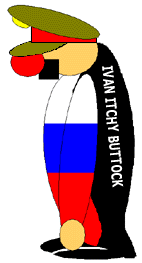The Sunday Funnies



CLICK HERE to have your mind read by the deviously inscrutable Russian Magic Square (thanks to RussianEnglish).
More Truth is Funnier than Fiction
Soviet Russians Duped into Planting a Living Swastika
The New York Times reports:
The forest stands overhead in the dusty mountain air, a dense composition of fir trees on a slope, planted by labor gangs decades ago. Its right angles are sharp and clear, forming a square cross with an upraised arm on one side and a turned-down arm on the other. Viewed from this remote village, the effect strongly suggests a living swastika, a huge and chilling symbol, out of place and time.
This is the so-called Eki Naryn swastika, a man-made arrangement of trees near the edge of the Himalayas. It is at least 60 years old, according to the region’s forestry service, and roughly 600 feet across. Legend has it that German prisoners of war, pressed into forestry duty after World War II, duped their Soviet guards and planted rows of seedlings in the shape of the emblem Hitler had chosen as his own.
More than 20 years later, the trees rose tall enough to be visible from the village beneath. Only then did the swastika appear, a time-delayed act of defiance by vanquished soldiers marooned in a corner of Stalin’s Soviet Union. For all the tidiness of legend, however, the tale is not quite true. The provenance of these trees presents a more complicated mystery than a silent subterfuge in a forgotten prison camp. The theory about the prisoners has survived for years, in part because about 1.3 million German soldiers have been missing in the former Soviet Union since the war, according to the German Red Cross. Many were forced to work. They mined uranium and coal, toiled on farms, erected buildings and built roads, railways and canals.
As many as 30,000 of them were sent to Central Asia, the German Red Cross says. The symmetry in the tree line, evidence of their defiance, by this telling, may be the Third Reich’s only practical joke. But aside from the presence of the tree formation itself, unraveling the origins of the lost Nazis’ presumed insubordination is a chore undercut by time. History has become malleable, a yarn by turns sinister, wry, clever and Soviet. It is also warped by errors, a cover-up, competing theories and lies. Yedil Musayev, a teacher, said the trees were planted in the 1940’s by Kyrgyz laborers from the sprawling Lenin Collective Farm, which managed the region’s high plateau. The farm’s managers consisted of Russians and Europeans, he said, sent to distant posts to battle illiteracy and improve efficiency.
Unbeknownst to the Kyrgyz laborers, he said, their forestry supervisor was an ethnic German who had been exiled to the east, as were many Germans during the war. He was a Nazi sympathizer, Mr. Musayev said. The forest was his design
Sultanbek Kandibayev, director of the regional forestry service, gave a different version, saying the trees were planted in 1953, after Stalin’s death, under the supervision of a woman who was a German nationalist.
Ulambek Sheripov, a deputy director, added detail, saying the woman hid her plans by having the slope planted a patch at a time. But he disagreed with his director about when the plantings occurred, saying a survey in 1991 estimated the trees were 50 years old at the time, meaning they were most likely planted before 1953.


















No comments:
Post a Comment